The Effect of Degradation on Cold Climate Building Energy Performance: A Comparison with Hot Climate Buildings
Abstract
:1. Introduction
- Evaluate the existing evidence on the performance degradation of various components of buildings in cold climates.
- Identify the effect of degradation on the energy performance of buildings in cold climates.
- Perform a comparative analysis of the results obtained in a cold climate with the previously obtained results in a hot–humid climate.
- Provide new recommendations as applied to cold climates and complement these with the existing guidance for hot–humid climates.
2. Literature Review
2.1. Existing Approaches to Assessing the Deterioration of Building Performance
2.2. Features of Building Components’ Degradation in Different Environmental Conditions
2.3. Literature Appraisal
3. The Case Studies
3.1. The Climate
3.2. Description of Buildings
4. Methodology
4.1. Research Methods
4.2. Elaboration of Probable Degradation Scenarios
4.3. Dynamic Thermal Simulations
5. Results and Discussion
5.1. The Relationship between IGU’s Degradation and Building’s Performance Deterioration
- The increase in energy consumption for heating due to IGU degradation in the more airtight and insulated detached house occurred more quickly (by 0.68–4.54% over 25 years) compared to the less airtight and insulated building (by 0.32–2.13%). It is noteworthy that according to scenario 1.4, energy consumption for heating is even slightly reduced (by less than 1%) due to the minor predominance of incoming solar gains over heat losses with this type of degradation.
- A similar situation was also observed in apartment buildings. In particular, the increase in energy consumption for heating due to the deterioration of window performance can reach 0.3–8.32% over 25 years in the more airtight and insulated apartment building and up to 0.51–3.35% in the less airtight and insulated building. In this way, it is quite clear that a more airtight and insulated shell of a building contributes to a faster response to the deterioration of the properties of its constituent elements: in this case, windows.
- It was also found that changes in the energy consumption of apartment buildings occurred faster than in detached houses (approximately 1.8 times in more airtight and insulated buildings and 1.6 times in less airtight and insulated buildings).

5.2. The Relationship between Thermal Insulation Degradation and Building’s Performance Deterioration
- It was found that more airtight and insulated buildings are more vulnerable to the degradation of thermal insulation than less airtight and insulated buildings. In particular, the possible increase in heating energy consumption might reach up to 8.1% in the more airtight and insulated detached house, and up to 6.76% in the less airtight and insulated detached house. In apartment buildings, these values were equal to 13.48% and 9.43%, respectively.
- The changes in heating energy consumption in apartment buildings occurred faster than in detached houses: approximately 1.7 times for more airtight and insulated buildings, and 1.4 times for less airtight and insulated buildings.
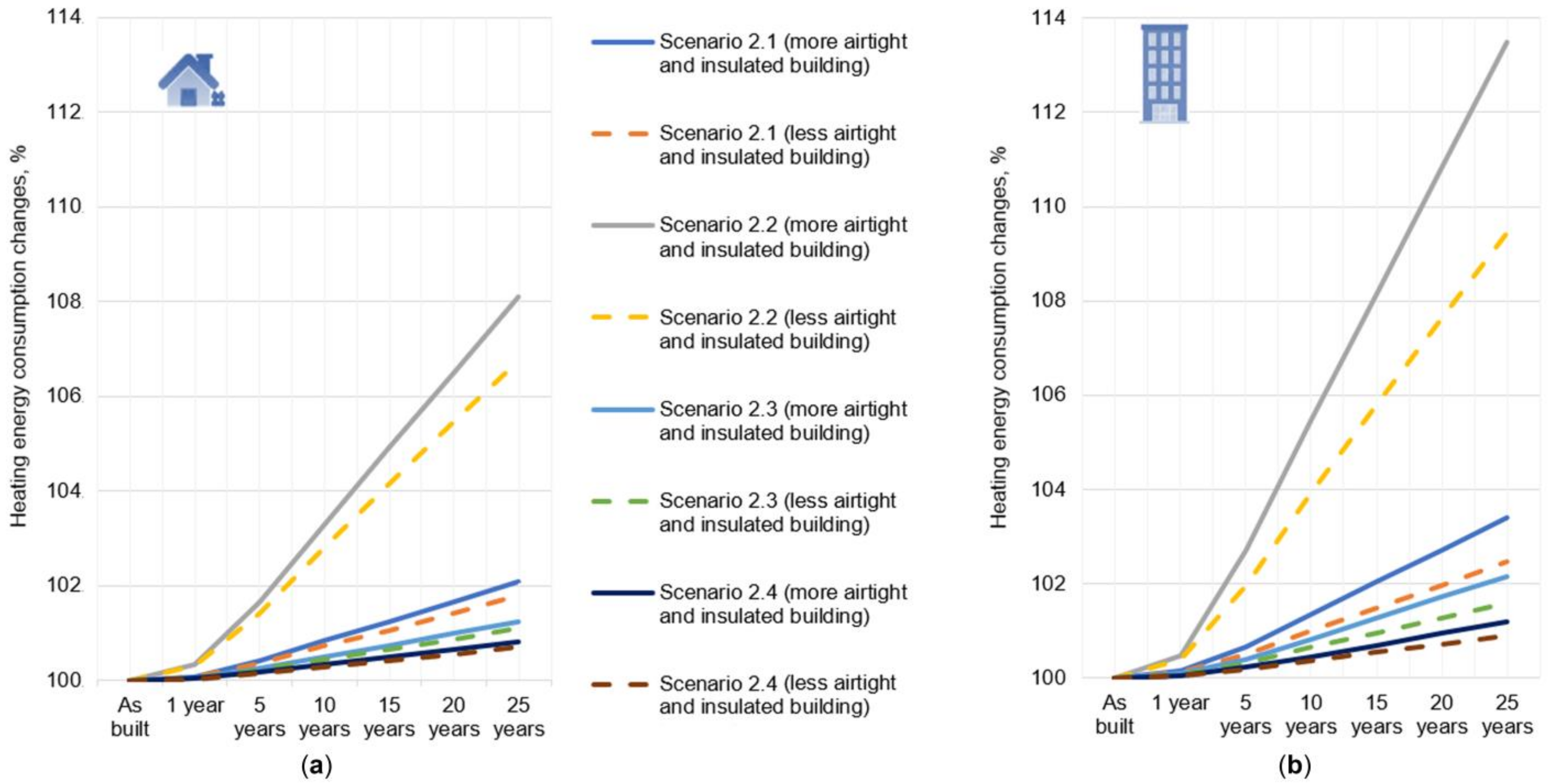
5.3. The Relationship between Airtightness Degradation and Building’s Performance Deterioration
- The increase in energy consumption for heating associated with an increase in air permeability occurred more slowly in the more airtight and insulated detached house (by 12.29–19.35% (26.46%) over 25 years) than in the less airtight and insulated building (by 13.57–21.36% (29.16%)). It is likely that the lower initial value of uncontrolled air flows in more airtight and insulated buildings contributes to a lesser impact of the degradation of airtightness on energy consumption. Moreover, a more insulated shell in this case also makes a positive contribution to curbing energy demand.
- In apartment buildings, on the other hand, the increase in energy consumption for heating occurred faster in the more airtight and insulated buildings (by 19.85–31.34% over 25 years) than in the less airtight and insulated buildings (by 16.77–26.33%). As such, this result was the opposite of the one obtained for the detached houses.
- If we consider the difference between detached and apartment buildings, then it was found that in apartment buildings, the change in energy consumption occurred faster than in detached houses (approximately 1.6 times for more airtight and insulated buildings and 1.2 times for less airtight and insulated buildings).

5.4. The Relationship between Mechanical Ventilation Heat Recovery Degradation and Building’s Performance Deterioration
5.5. The Relationship between PV Module Degradation and Building’s Performance Deterioration
5.6. The Combined Impact of Degrading Building Components
6. A Set of Guidelines
6.1. Recommendations for the Entire Building
- The energy performance of buildings in a cold climate is more vulnerable to degradation than in a hot–humid climate. Therefore, the aspect of the climatic region where the building is located is important when considering possible changes in its energy consumption under the influence of the degradation of various building components. In particular, the following indicators of a faster increase in energy demand in a cold climate compared to a hot–humid climate can be distinguished (how many times):
- •
- for more airtight and insulated detached houses: 1.6–1.9
- •
- for less airtight and insulated detached houses: 1.4
- •
- for more airtight and insulated apartment buildings: 2.8–3.6
- •
- for less airtight and insulated apartment buildings: 1.9–2.1
- More airtight and insulated buildings are more vulnerable to the degradation of various building components, compared to less airtight and insulated buildings. This is evidenced by the fact that the increase in energy demand over time in the first case occurs faster than in the second. In this regard, it is obvious that the importance of the quality and reliability of the building materials and structures used will increase with the increase in the level of airtightness and insulation of the projected building. The following indicators of a faster increase in energy consumption in more airtight and insulated buildings can be distinguished (how many times):
- •
- for detached houses in a cold climate: 1.05–1.2
- •
- for apartment buildings in a cold climate: 1.4–1.6
- •
- for detached houses in a hot–humid climate: 1.1
- •
- for apartment buildings in a hot–humid climate: 1.1
- The greatest deterioration in energy performance of buildings due to degradation occurs within the first years of their operation. In addition, such an initial increase in energy consumption in a cold climate has significantly higher values than in a hot–humid climate.
6.2. Recommendations Concerning Possible Insulated Glass Unit’s Degradation
- With the degradation of IGU, the increase in energy consumption occurs at a faster rate in more airtight and insulated buildings. This conclusion is valid for both cold and hot climates. This means that the requirements for the quality of the windows used increase in direct proportion to the level of airtightness and insulation in buildings. As indicative quantitative indicators of this pattern, it is possible to refer to the established dependencies in Figure 9 in this study and in [14].
- It is important to note that most likely, the change in energy consumption during IGU degradation occurs more slowly in apartment buildings than in detached buildings (with an average WWR indicator in a building of about 27–30%).
- In addition, as indicated in [14], in hot and humid climates, special attention should be paid to the reliability of low-emission coatings on IGU since their degradation leads to a significant growth in cooling energy demand.
6.3. Recommendations Concerning Possible Thermal Insulation Degradation
- It should be borne in mind that the consequences of degradation of thermal insulation in a cold climate are more significant than in a hot–humid climate, which requires a more cautious choice of building insulation materials in the first case. This recommendation is based on the established fact that with the degradation of thermal insulation, the increase in heating demand in cold climates occurs more rapidly than the increase in cooling demand in hot–humid climates. The estimated quantitative indicators of this dependence can be seen in Figure 10 in this study and in [14].
- The deterioration of the performance of the thermal insulation of walls has more significant negative consequences for the energy performance of buildings compared with the deterioration of the thermal insulation of the roof. This pattern is observed in both climatic regions. It is possible to distinguish the following gap between the influence of thermal insulation of walls and roofs (how many times): for the detached house in a cold climate: 1.5; for the apartment building in a cold climate: 1.8; for the detached house in a hot–humid climate: 1.8; for the apartment building in a hot–humid climate: 1.5.
6.4. Recommendations Concerning Possible Airtightness Degradation
6.5. Recommendations Concerning Possible Degradation of Solar Reflectance of the Building Envelope
6.6. Recommendations Concerning Possible Performance Degradation of the MVHR System
- The efficiency of the MVHR system in more airtight and insulated buildings is higher than in less airtight and insulated buildings.
- The design of the MVHR system should be carried out in close relationship with the main indicators of the airtightness and insulation of the building envelope, primarily airtightness. The effect of the degradation of various elements of the building envelope on the efficiency of the heat recovery system can be seen in Figure 14. The following coefficients can be distinguished to reflect a possible decrease in the performance of heat recovery: with degradation of IGU: 0.94–0.99; with degradation of thermal insulation: 0.9–0.99; with degradation of airtightness: 0.78–0.9.
- The performance of the heat recovery of typical mechanical ventilation systems installed in apartment blocks is more susceptible to the effects of degradation compared to those in detached houses, i.e., the increase in heating demand during the degradation of this system in the first case occurs faster.
6.7. Recommendations Concerning Possible PV Module Degradation
6.8. Application of Graphic Material
7. Output and Impacts
- The degradation of building components such as IGUs, thermal insulation, airtightness, heat recovery units of MVHR systems, and PV modules greatly affected the increase in heating demand in cold climates.
- Taking the degradation factor into account, it was possible to identify the following main patterns: (1) Degradation processes had a more significant influence on the deterioration of the performance indicators of buildings in a cold climate compared to a hot–humid climate; (2) The greatest influence on the increase in energy consumption in a hot–humid climate was exerted by such indicators as the deterioration of low-emission coatings on windows, as well as airtightness degradation; in turn, in a cold climate, the deterioration of airtightness and heat recovery performance were of key importance; (3) The most substantial growth in energy demand is observed at the very beginning of building operation, and the sharpest jump in the deterioration of energy performance also occurs in cold climates; (4) It was revealed that the higher the level of airtightness and insulation of the building, the more vulnerable it is to degradation and ageing processes; (5) The constancy of the thermal insulation properties of the walls is more important than the thermal insulation of the roof in ensuring the stability of energy consumption in buildings in the long run; (6) As for building services, it was found that the greatest impact of the decrease in the performance of heat recovery in the mechanical ventilation system was a deterioration in the airtightness of buildings; (7) The degradation of PV modules in a cold climate also led (albeit to a lesser extent than in hot–humid climates) to a significant increase in energy consumption from the power grid.
- It is also possible to note some interesting relationships established between the results obtained and the features of degradation of various components of buildings identified during the literature review. For instance, the fact noted by some scientists that in hotter conditions, under the influence of high temperatures affecting the sealants, the service life of IGUs is significantly lower than in colder conditions, which can be to some extent consistent with the results obtained, according to which a possible increase in cooling demand due to the degradation of a low-emission coating in a hot–humid climate was much higher than the values obtained in this study in a cold climate. Interesting results were obtained regarding the effect of thermal insulation in both climatic conditions. Therefore, despite the fact that scientific research generally confirms the linear relationship between thermal conductivity and temperature, the results obtained show the high importance of the degradation of thermal insulation in cold climates. In this way, it can be argued that heat transfer in a cold climate is more dynamic, and thermal insulation is rightfully considered one of the key measures to increase energy efficiency according to the world’s leading guidelines. The established fact that uncontrolled air flows cause significantly greater global energy losses during heating than during cooling is also consistent with the results obtained in this work of a faster increase in energy demand in buildings due to the deterioration of airtightness in a cold climate compared with a hot–humid climate. The close relationship revealed in this study between the performance of the mechanical ventilation system’s heat recovery and the airtightness also confirms the identified statements about the efficiency of the heat recovery system precisely in conditions of high building envelope performance.
- The set of guidelines developed on the basis of the revealed patterns of behaviour of buildings in the ageing process embodies one aspect of the novelty of this study. In particular, in addition to enriching the general knowledge on this topic, the identified dependencies made it possible to quantify and correlate various factors that aggravate or, conversely, weaken the effect of degradation on increasing energy demand. In this way, the formulated recommendations will allow specialists in various fields at various stages of the life cycle of buildings to mitigate the effect of unavoidable degradation.
8. Conclusions and Recommendations
Author Contributions
Funding
Institutional Review Board Statement
Informed Consent Statement
Data Availability Statement
Conflicts of Interest
References
- International Energy Agency. Buildings. Available online: https://www.iea.org/reports/buildings (accessed on 10 January 2023).
- World Green Building Council. EU Policy Whole Life Carbon Roadmap #BuildingLife. 2022. Available online: https://worldgbc.org/article/eu-policy-whole-life-carbon-roadmap-for-buildings (accessed on 10 January 2023).
- Röck, M.; Saade, M.R.M.; Balouktsi, M.; Rasmussen, F.N.; Birgisdottir, H.; Frischknecht, R.; Habert, G.; Lützkendorf, T.; Passer, A. Embodied GHG emissions of buildings–The hidden challenge for effective climate change mitigation. Appl. Energy 2020, 258, 114107. [Google Scholar] [CrossRef]
- United Nations Environment Programme. Global Status Report for Buildings and Construction: Towards a Zero-emission, Efficient and Resilient Buildings and Construction Sector. 2022. Available online: https://wedocs.unep.org/handle/20.500.11822/41133 (accessed on 11 January 2023).
- European Commission. In Focus: Energy Efficiency in Buildings. Available online: https://commission.europa.eu/news/focus-energy-efficiency-buildings-2020-02-17_en#:~:text=Energy%20efficient%20buildings%20will%20result,air%20quality%20and%20improved%20health (accessed on 11 January 2023).
- Li, L.; Wang, Y.; Wang, M.; Hu, W.; Sun, Y. Impacts of multiple factors on energy consumption of aging residential buildings based on a system dynamics model--Taking Northwest China as an example. J. Build. Eng. 2021, 44, 102595. [Google Scholar] [CrossRef]
- Aksoezen, M.; Daniel, M.; Hassler, U.; Kohler, N. Building age as an indicator for energy consumption. Energy Build. 2015, 87, 74–86. [Google Scholar] [CrossRef]
- Mohamed, S.; Smith, R.; Rodrigues, L.; Omer, S.; Calautit, J. The correlation of energy performance and building age in UK schools. J. Build. Eng. 2021, 43, 103141. [Google Scholar] [CrossRef]
- Feng, H.; Liyanage, D.R.; Karunathilake, H.; Sadiq, R.; Hewage, K. BIM-based life cycle environmental performance assessment of single-family houses: Renovation and reconstruction strategies for aging building stock in British Columbia. J. Clean. Prod. 2020, 250, 119543. [Google Scholar] [CrossRef]
- Thomas, A.; Menassa, C.C.; Kamat, V.R. System dynamics framework to study the effect of material performance on a building’s lifecycle energy requirements. J. Comput. Civ. Eng. 2016, 30, 04016034. [Google Scholar] [CrossRef]
- De Wilde, P.; Tian, W.; Augenbroe, G. Longitudinal prediction of the operational energy use of buildings. Build. Environ. 2011, 46, 1670–1680. [Google Scholar] [CrossRef]
- #BuildingToCOP. Built Environment Highlights from COP26. Available online: https://buildingtocop.org (accessed on 20 October 2022).
- World Business Council for Sustainable Development. Net Zero Buildings: What does It Mean? (COP27). Available online: https://events.wbcsd.org/virtual-meetings/project/net-zero-buildings-what-does-it-mean (accessed on 11 January 2023).
- Taki, A.; Zakharanka, A. The Impact of Degradation on a Building’s Energy Performance in Hot-Humid Climates. Sustainability 2023, 15, 1145. [Google Scholar] [CrossRef]
- Thomas, A.; Menassa, C.C.; Kamat, V.R. A Framework to Understand Effect of Building Systems Deterioration on Life Cycle Energy. Procedia Eng. 2015, 118, 507–514. [Google Scholar] [CrossRef] [Green Version]
- Litti, G.; Audenaert, A.; Lavagna, M. Life cycle operating energy saving from windows retrofitting in heritage buildings accounting for technical performance decay. J. Build. Eng. 2018, 17, 135–153. [Google Scholar] [CrossRef]
- Eleftheriadis, G.; Hamdy, M. Impact of building envelope and mechanical component degradation on the whole building performance: A review paper. Energy Procedia 2017, 132, 321–326. [Google Scholar] [CrossRef]
- Eleftheriadis, G.; Hamdy, M. The Impact of Insulation and HVAC Degradation on Overall Building Energy Performance: A Case Study. Buildings 2018, 8, 23. [Google Scholar] [CrossRef] [Green Version]
- Waddicor, D.A.; Fuentes, E.; Sisó, L.; Salom, J.; Favre, B.; Jiménez, C.; Azar, M. Climate change and building ageing impact on building energy performance and mitigation measures application: A case study in Turin, northern Italy. Build. Environ. 2016, 102, 13–25. [Google Scholar] [CrossRef]
- Danza, L.; Belussi, L.; Guazzi, G.; Meroni, I.; Salamone, F. Durability of technologies in the keeping of ZEB’s performances. Energy Procedia 2018, 148, 138–145. [Google Scholar] [CrossRef]
- De Masi, R.F.; Ruggiero, S.; Vanoli, G.P. Multi-layered wall with vacuum insulation panels: Results of 5-years in-field monitoring and numerical analysis of aging effect on building consumptions. Appl. Energy 2020, 278, 115605. [Google Scholar] [CrossRef]
- D’Agostino, D.; Landolfi, R.; Nicolella, M.; Minichiello, F. Experimental Study on the Performance Decay of Thermal Insulation and Related Influence on Heating Energy Consumption in Buildings. Sustainability 2022, 14, 2947. [Google Scholar] [CrossRef]
- Stazi, F.; Tittarelli, F.; Politi, G.; Di Perna, C.; Munafò, P. Assessment of the actual hygrothermal performance of glass mineral wool insulation applied 25 years ago in masonry cavity walls. Energy Build. 2014, 68, 292–304. [Google Scholar] [CrossRef]
- Asphaug, S.K.; Jelle, B.P.; Gullbrekken, L.; Uvsløkk, S. Accelerated ageing and durability of double-glazed sealed insulating window panes and impact on heating demand in buildings. Energy Build. 2016, 116, 395–402. [Google Scholar] [CrossRef]
- Mastrapostoli, E.; Santamouris, M.; Kolokotsa, D.; Vassilis, P.; Venieri, D.; Gompakis, K. On the ageing of cool roofs: Measure of the optical degradation, chemical and biological analysis and assessment of the energy impact. Energy Build. 2016, 114, 191–199. [Google Scholar] [CrossRef]
- Paolini, R.; Zani, A.; Poli, T.; Antretter, F.; Zinzi, M. Natural aging of cool walls: Impact on solar reflectance, sensitivity to thermal shocks and building energy needs. Energy Build. 2017, 153, 287–296. [Google Scholar] [CrossRef]
- Gupta, R.; Kotopouleas, A. Magnitude and extent of building fabric thermal performance gap in UK low energy housing. Appl. Energy 2018, 222, 673–686. [Google Scholar] [CrossRef]
- Gupta, R.; Kapsali, M.; Howard, A. Evaluating the influence of building fabric, services and occupant related factors on the actual performance of low energy social housing dwellings in UK. Energy Build. 2018, 174, 548–562. [Google Scholar] [CrossRef] [Green Version]
- Marshall, A.; Fitton, R.; Swan, W.; Farmer, D.; Johnston, D.; Benjaber, M.; Ji, Y. Domestic building fabric performance: Closing the gap between the in situ measured and modelled performance. Energy Build. 2017, 150, 307–317. [Google Scholar] [CrossRef]
- Feist, W.; Pfluger, R.; Hasper, W. Durability of building fabric components and ventilation systems in passive houses. Energy Effic. 2020, 13, 1543–1559. [Google Scholar] [CrossRef] [Green Version]
- Pilli-Sihvola, K.; Aatola, P.; Ollikainen, M.; Tuomenvirta, H. Climate change and electricity consumption—Witnessing increasing or decreasing use and costs? Energy Policy 2010, 38, 2409–2419. [Google Scholar] [CrossRef]
- Smagulov, Z.; Anapiya, A.; Dikhanbayeva, D.; Rojas-Solorzano, L. Impact of Module Degradation on the Viability of On-Grid Photovoltaic Systems in Mediterranean Climate: The Case of Shymkent Airport. Int. J. Renew. Energy Dev. 2021, 10, 139–147. [Google Scholar] [CrossRef]
- Axelarris, L.; Cooke, A.; Fredeen, C.; Garber-Slaght, R.; Leffel, E.; Ricketts, L.; Rose, W.; Zarling, J.P.; Zhivov, A. Building Envelope Characteristics in Cold Climates. ASHRAE Trans. 2021, 127, 583. [Google Scholar]
- Kralj, A.; Drev, M.; Žnidaršič, M.; Hafner, J.; Černe, B. Multipane Glazing Durability: Report. Available online: https://www.researchgate.net/publication/327467400_Multipane_glazing_durability (accessed on 10 January 2023).
- Insulation Manufacturers Association. Insulation for Sustainability: A Guide. 2020. Available online: https://xco2.com/insulation-for-sustainability-a-guide (accessed on 20 January 2023).
- XCO2. Insulation for Sustainability: A Guide. 2020. Available online: https://highperformanceinsulation.eu/wp-content/uploads/2016/08/sustainability_a_guide.pdf (accessed on 20 January 2023).
- Taleb, H.M. Using passive cooling strategies to improve thermal performance and reduce energy consumption of residential buildings in U.A.E. buildings. Front. Archit. Res. 2014, 3, 154–165. [Google Scholar] [CrossRef] [Green Version]
- Ihm, P.; Krarti, M. Design optimization of energy efficient residential buildings in Tunisia. Build. Environ. 2012, 58, 81–90. [Google Scholar] [CrossRef]
- Schnieders, J.; Feist, W.; Rongen, L. Passive Houses for different climate zones. Energy Build. 2015, 105, 71–87. [Google Scholar] [CrossRef]
- Pásztory, Z. An overview of factors influencing thermal conductivity of building insulation materials. J. Build. Eng. 2021, 44, 102604. [Google Scholar] [CrossRef]
- Molleti, S.; Van Reenen, D. Effect of Temperature on Long-Term Thermal Conductivity of Closed-Cell Insulation Materials. Buildings 2022, 12, 425. [Google Scholar] [CrossRef]
- Berardi, U. The impact of aging and environmental conditions on the effective thermal conductivity of several foam materials. Energy 2019, 182, 777–794. [Google Scholar] [CrossRef]
- Belanger, D.; Berardi, U. The impact of aging on the effective thermal conductivity of foam insulation: A simulation investigation using laboratory characterization data. In Proceedings of the 10th conference of IBPSA-Canada, Montreal, QC, Canada, 9–10 May 2018. [Google Scholar]
- Dong, Y.; Kong, J.; Mousavi, S.; Rismanchi, B.; Yap, P.S. Wall Insulation Materials in Different Climate Zones: A Review on Challenges and Opportunities of Available Alternatives. Thermo 2023, 3, 38–65. [Google Scholar] [CrossRef]
- Nagy, B.; Simon, T.K.; Nemes, R. Effect of built-in mineral wool insulations durability on its thermal and mechanical performance. J. Therm. Anal. Calorim. 2020, 139, 169–181. [Google Scholar] [CrossRef] [Green Version]
- Molleti, S.; Lefebvre, D.; van Reenen, D. Long-term in-situ assessment of vacuum insulation panels for integration into roofing systems: Five years of field-performance. Energy Build. 2018, 168, 97–105. [Google Scholar] [CrossRef]
- Johansson, P.; Adl-Zarrabi, B.; Kalagasidis, A.S. Evaluation of 5 years’ performance of VIPs in a retrofitted building façade. Energy Build. 2016, 130, 488–494. [Google Scholar] [CrossRef]
- Stazi, F.; Di Perna, C.; Munafò, P. Durability of 20-year-old external insulation and assessment of various types of retrofitting to meet new energy regulations. Energy Build. 2009, 41, 721–731. [Google Scholar] [CrossRef]
- Bomberg, M.; Kisilewicz, T.; Nowak, K. Is there an optimum range of airtightness for a building? J. Build. Phys. 2016, 39, 395–421. [Google Scholar] [CrossRef]
- Moujalled, B.; Leprince, V.; Berthault, S.; Litvak, A.; Hurel, N. Mid-term and long-term changes in building airtightness: A field study on low-energy houses. Energy Build. 2021, 250, 111257. [Google Scholar] [CrossRef]
- Sherman, M.; Chan, W.; Walker, I. Durable Airtightness in Single-Family Dwellings: Field Measurements and Analysis. Int. J. Vent. 2015, 14, 27–38. [Google Scholar] [CrossRef] [Green Version]
- Zheng, H.; Long, E.; Cheng, Z.; Yang, Z.; Jia, Y. Experimental exploration on airtightness performance of residential buildings in the hot summer and cold winter zone in China. Build. Environ. 2022, 214, 108848. [Google Scholar] [CrossRef]
- Wahlgren, P. Seasonal variation in airtightness. In Proceedings of the 35th AIVC Conference “Ventilation and Airtightness in Transforming the Building Stock to High Performance”, Poznań, Poland, 24–25 September 2014. [Google Scholar]
- Feijó-Muñoz, J.; Pardal, C.; Echarri, V.; Fernández-Agüera, J.; Assiego de Larriva, R.; Montesdeoca Calderín, M.; Poza-Casado, I.; Padilla-Marcos, M.Á.; Meiss, A. Energy impact of the air infiltration in residential buildings in the Mediterranean area of Spain and the Canary islands. Energy Build. 2019, 188, 226–238. [Google Scholar] [CrossRef]
- Boixo, S.; Diaz-Vicente, M.; Colmenar, A.; Castro, M.A. Potential energy savings from cool roofs in Spain and Andalusia. Energy 2012, 38, 425–438. [Google Scholar] [CrossRef]
- Pal, R.K.; Goyal, P.; Sehgal, S. Thermal performance of buildings with light colored exterior materials. Mater. Today Proc. 2020, 28, 1307–1313. [Google Scholar] [CrossRef]
- Shen, H.; Tan, H.; Tzempelikos, A. The effect of reflective coatings on building surface temperatures, indoor environment and energy consumption—An experimental study. Energy Build. 2011, 43, 573–580. [Google Scholar] [CrossRef]
- Dias, D.; Machado, J.; Leal, V.; Mendes, A. Impact of using cool paints on energy demand and thermal comfort of a residential building. Appl. Therm. Eng. 2014, 65, 273–281. [Google Scholar] [CrossRef] [Green Version]
- Ozel, M. The influence of exterior surface solar absorptivity on thermal characteristics and optimum insulation thickness. Renew. Energy 2012, 39, 347–355. [Google Scholar] [CrossRef]
- Bai, H.Y.; Liu, P.; Alonso, M.J.; Mathisen, H.M. A review of heat recovery technologies and their frost control for residential building ventilation in cold climate regions. Renew. Sustain. Energy Rev. 2022, 162, 112417. [Google Scholar] [CrossRef]
- Tommerup, H.; Svendsen, S. Energy savings in Danish residential building stock. Energy Build. 2006, 38, 618–626. [Google Scholar] [CrossRef]
- Cutland, N. Lessons from Germany’s Passivhaus Experience. NHBC 2012. Available online: https://www.nhbcfoundation.org/publication/lessons-from-germanys-passivhaus-experience/ (accessed on 1 February 2023).
- Ploskić, A.; Wang, Q. Evaluating the potential of reducing peak heating load of a multi-family house using novel heat recovery system. Appl. Therm. Eng. 2018, 130, 1182–1190. [Google Scholar] [CrossRef]
- Zhao, L.; Liu, J. Physical environmental and behavioral drivers of heat recovery ventilation system feasibility in various climate zones. Energy Convers. Manag. 2022, 259, 115586. [Google Scholar] [CrossRef]
- El Fouih, Y.; Stabat, P.; Rivière, P.; Hoang, P.; Archambault, V. Adequacy of air-to-air heat recovery ventilation system applied in low energy buildings. Energy Build. 2012, 54, 29–39. [Google Scholar] [CrossRef]
- Juodis, E. Extracted ventilation air heat recovery efficiency as a function of a building’s thermal properties. Energy Build. 2006, 38, 568–573. [Google Scholar] [CrossRef]
- Roulet, C.A.; Heidt, F.D.; Foradini, F.; Pibiri, M.C. Real heat recovery with air handling units. Energy Build. 2001, 33, 495–502. [Google Scholar] [CrossRef]
- Merzkirch, A.; Maas, S.; Scholzen, F.; Waldmann, D. Field tests of centralized and decentralized ventilation units in residential buildings—Specific fan power, heat recovery efficiency, shortcuts and volume flow unbalances. Energy Build. 2016, 116, 376–383. [Google Scholar] [CrossRef]
- Sharpe, T.; McGill, G.; Gupta, R.; Gregg, M.; Mawditt, I. Characteristics and performance of MVHR systems A meta study of MVHR systems used in the Innovate UK Building Performance Evaluation Programme. 2016. Available online: https://radar.gsa.ac.uk/4073/1/MVHR%20Meta%20Study%20Report%20March%202016%20FINAL%20PUBLISHED.pdf (accessed on 13 February 2023).
- Li, J.; Shao, S.; Wang, Z.; Xie, G.; Wang, Q.; Xu, Z.; Han, L.; Gou, X. A review of air-to-air membrane energy recovery technology for building ventilation. Energy Build. 2022, 265, 112097. [Google Scholar] [CrossRef]
- Omazic, A.; Oreski, G.; Halwachs, M.; Eder, G.C.; Hirschl, C.; Neumaier, L.; Pinter, G.; Erceg, M. Relation between degradation of polymeric components in crystalline silicon PV module and climatic conditions: A literature review. Sol. Energy Mater. Sol. Cells 2019, 192, 123–133. [Google Scholar] [CrossRef]
- Osterwald, C.R.; Adelstein, J.; del Cueto, J.A.; Kroposki, B.; Trudell, D.; Moriarty, T. Comparison of Degradation Rates of Individual Modules Held at Maximum Power. In Proceedings of the 2006 IEEE 4th World Conference on Photovoltaic Energy Conference, Waikoloa, HI, USA, 7–12 May 2006; pp. 2085–2088. [Google Scholar] [CrossRef] [Green Version]
- Strevel, N.; Trippel, L.; Gloeckler, M. Performance characterization and superior energy yield of First Solar PV power plants in high-temperature conditions. Photovolt. Int. 2012, 17, 7. [Google Scholar]
- Vazquez, M.; Rey-Stolle, I. Photovoltaic module reliability based on field degradation studies. Prog. Photovolt. Res. Appl. 2008, 16, 419–433. [Google Scholar] [CrossRef] [Green Version]
- Ye, J.Y.; Reindl, T.; Aberle, A.G.; Walsh, T.M. Performance degradation of various PV module technologies in tropical Singapore. IEEE J. Photovolt. 2014, 4, 1288–1294. [Google Scholar] [CrossRef]
- Halwachs, M.; Berger, K.; Maul, L.; Neumaier, L.; Voronko, Y.; Mihaljevic, A.; Hirschl, C. Descriptive statistics on the climate related performance and reliability issues from global PV installations. In Proceedings of the 33rd European Photovoltaic Solar Energy Conference and Exhibition, Amsterdam, The Netherlands, 25–29 September 2017; pp. 1–3. [Google Scholar]
- Dubey, R.; Chattopadhyay, S.; Kuthanazhi, V.; John, J.J.; Vasi, J.; Kottantharayil, A.; Arora, B.M.; Narsimhan, K.L.; Kuber, V.; Solanki, C.S.; et al. Performance degradation in field-aged crystalline silicon PV modules in different indian climatic conditions. In Proceedings of the 2014 IEEE 40th Photovoltaic Specialist Conference (PVSC), Denver, CO, USA, 8–13 June 2014; pp. 3182–3187. [Google Scholar] [CrossRef]
- Malvoni, M.; Leggieri, A.; Maggiotto, G.; Congedo, P.M.; De Giorgi, M.G. Long term performance, losses and efficiency analysis of a 960kWP photovoltaic system in the Mediterranean climate. Energy Convers. Manag. 2017, 145, 169–181. [Google Scholar] [CrossRef]
- Jordan, D.; Kurtz, S.; VanSant, K.; Newmiller, J. Compendium of photovoltaic degradation rates. Prog. Photovolt. Res. Appl. 2016, 24, 978–989. [Google Scholar] [CrossRef]
- Beck, H.E.; Zimmermann, N.E.; McVicar, T.R.; Vergopolan, N.; Berg, A.; Wood, E.F. Present and future Köppen-Geiger climate classification maps at 1-km resolution. Sci. Data 2018, 5, 1–12. [Google Scholar] [CrossRef] [PubMed] [Green Version]
- Mourshed, M. Climatic parameters for building energy applications: A temporal-geospatial assessment of temperature indicators. Renew. Energy 2016, 94, 55–71. [Google Scholar] [CrossRef] [Green Version]
- Bertosh, E. Vulnerability and Adaptation to Climate Change in Belarus: National Report. Eastern Countries Forum on Climate Change, Minsk. 2014. Available online: https://www.minpriroda.gov.by/uploads/files/Otsenka-ujazvimosti-Belarusi-Rus.pdf (accessed on 10 February 2023).
- Leonovich, I.I. The Climate of Republic of Belarus; Minsk, BNTU. 2012. Available online: https://rep.bntu.by/handle/data/3501 (accessed on 13 February 2023).
- BelStat. Final Consumption of Fuel and Energy Resources by Consumption Sectors. Available online: https://www.belstat.gov.by/ofitsialnaya-statistika/realny-sector-ekonomiki/energeticheskaya-statistika/anual-dannye/konechnoe-potreblenie-energii-/ (accessed on 28 October 2022).
- BelStat. Housing Construction in the Republic of Belarus: Statistical Compendium. Minsk: Statistical Committee of the Republic of Belarus. 2014. Available online: https://www.belstat.gov.by/ofitsialnaya-statistika/publications/izdania/public_compilation/index_3486 (accessed on 10 February 2023).
- Kucheravy, A. The First Multicomfort House. Available online: http://kucheravy.archi/1-j-multikomfortnyj-dom-v-belarusi (accessed on 21 August 2022).
- Soroka, M. Underfloor Heating and No Radiators. Take a Look at What the First Energy-Efficient Class A+ Building in Belarus Looks Like. Available online: https://realt.by/brest-region/news/article/26256 (accessed on 21 August 2022).
- Krasovskaya, O. The Owner of the Most Energy-Efficient Detached House in the Country. Available online: https://realt.onliner.by/2015/12/07/energo-6 (accessed on 22 August 2022).
- Rossetti, M.D. Simulation Modeling and Arena, 2nd ed.; John Wiley & Sons, Inc.: Hoboken, NJ, USA, 2016; pp. 8–15. [Google Scholar]
- DesignBuilder. Designbuilder Software Features, Simulation Made Easy. 2022. Available online: https://designbuilder.co.uk (accessed on 3 January 2023).
- EnergyPlus. EnergyPlus Software Features. 2022. Available online: https://energyplus.net (accessed on 3 January 2023).
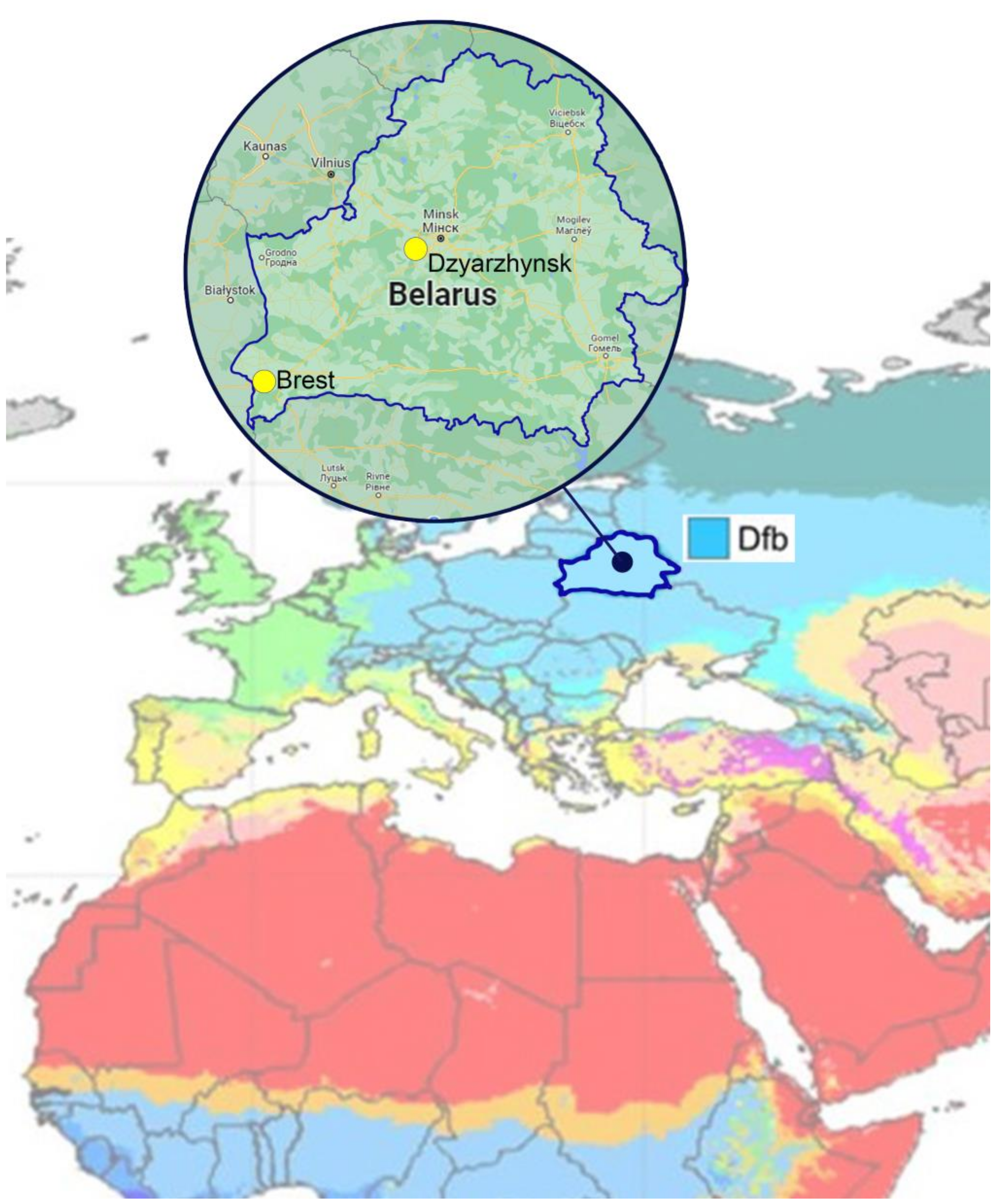
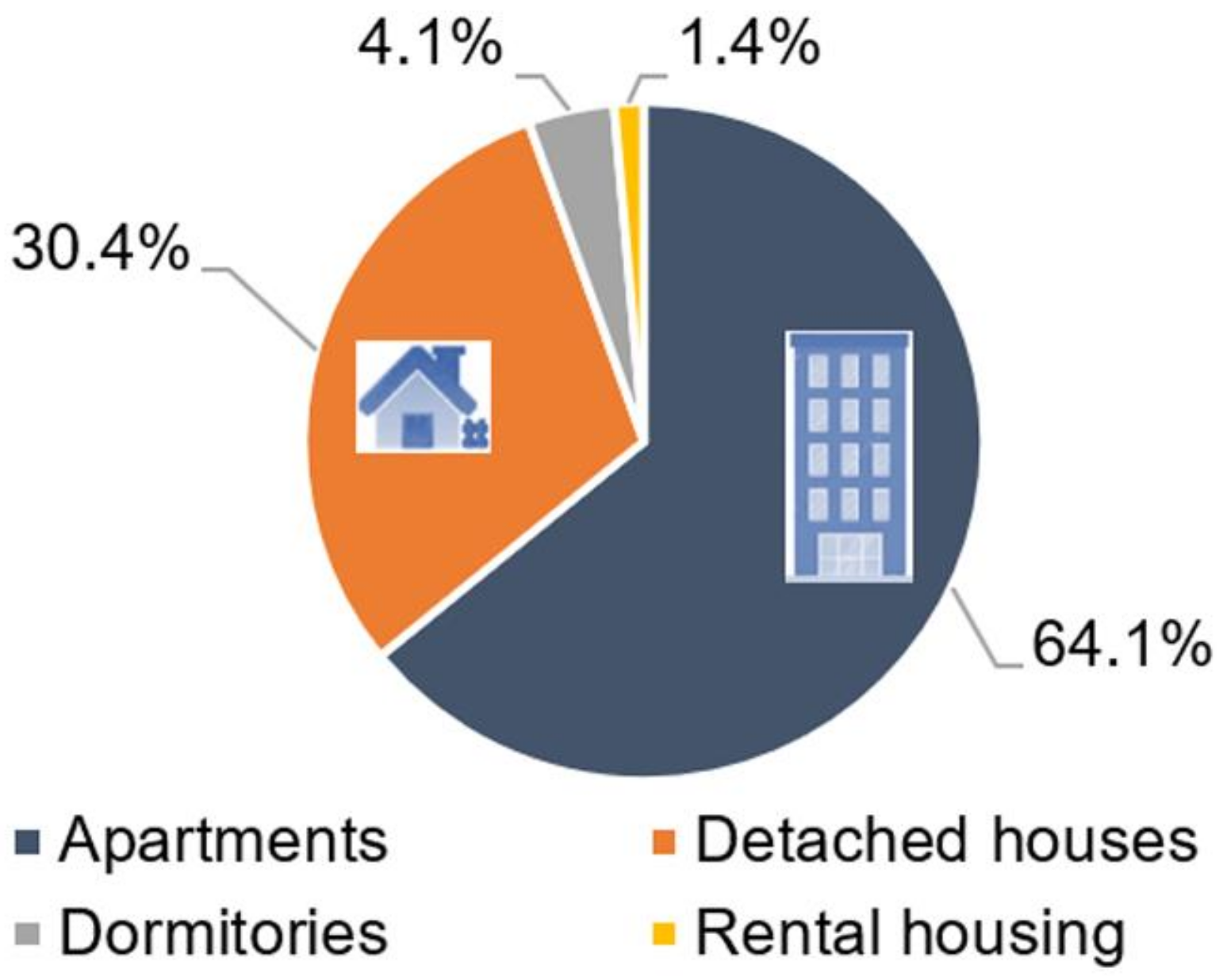
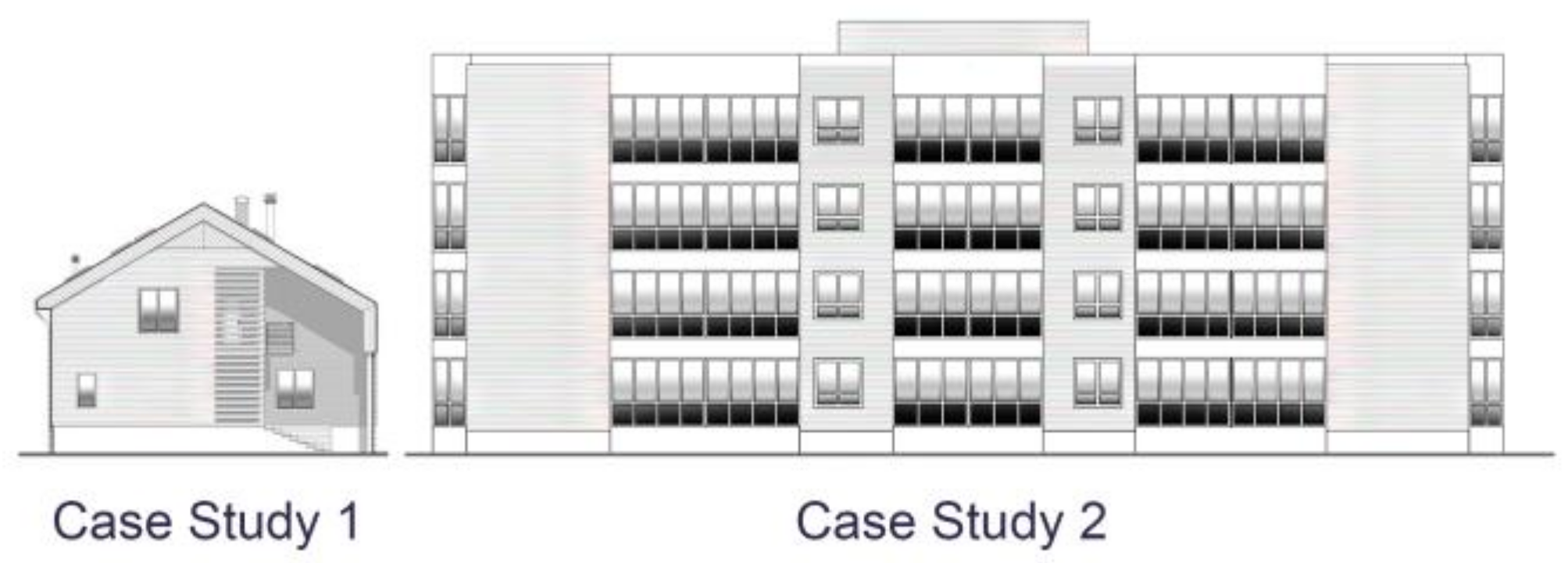
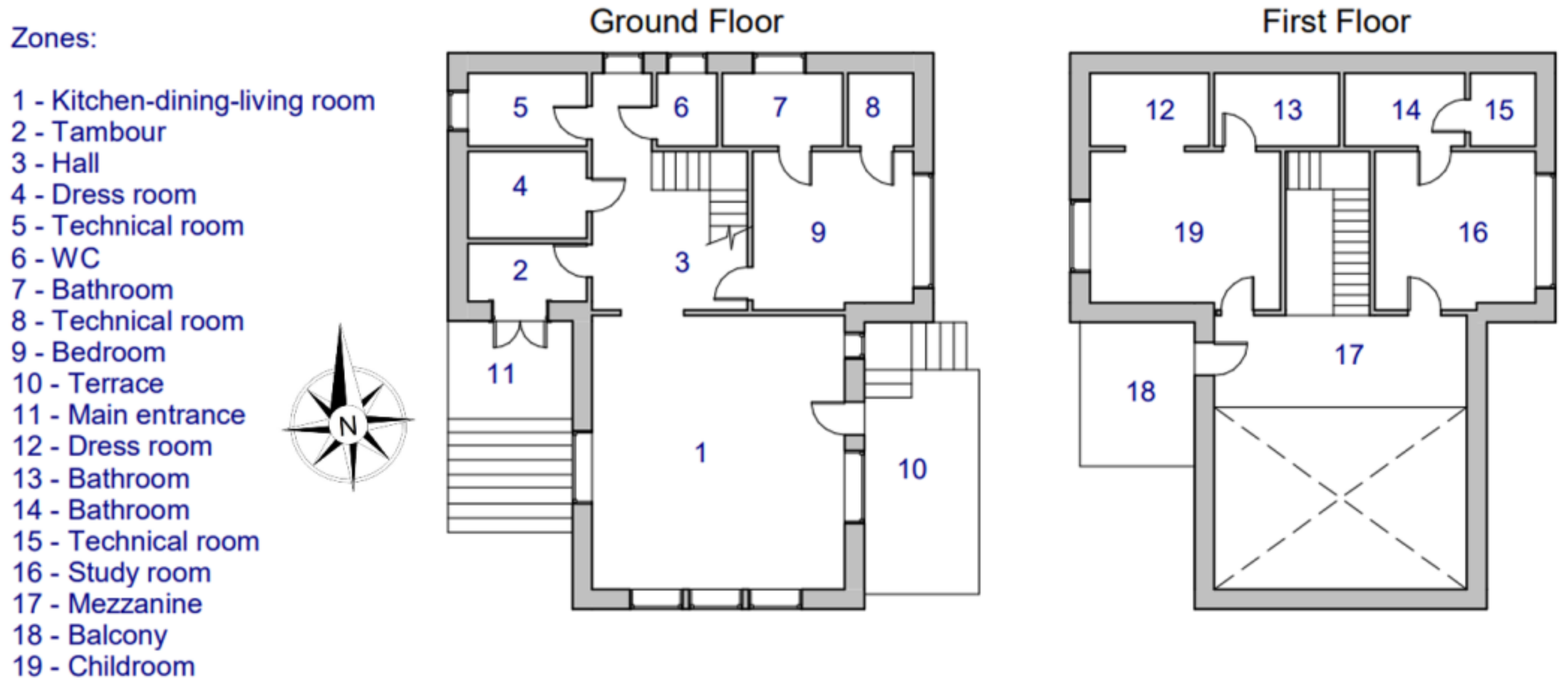

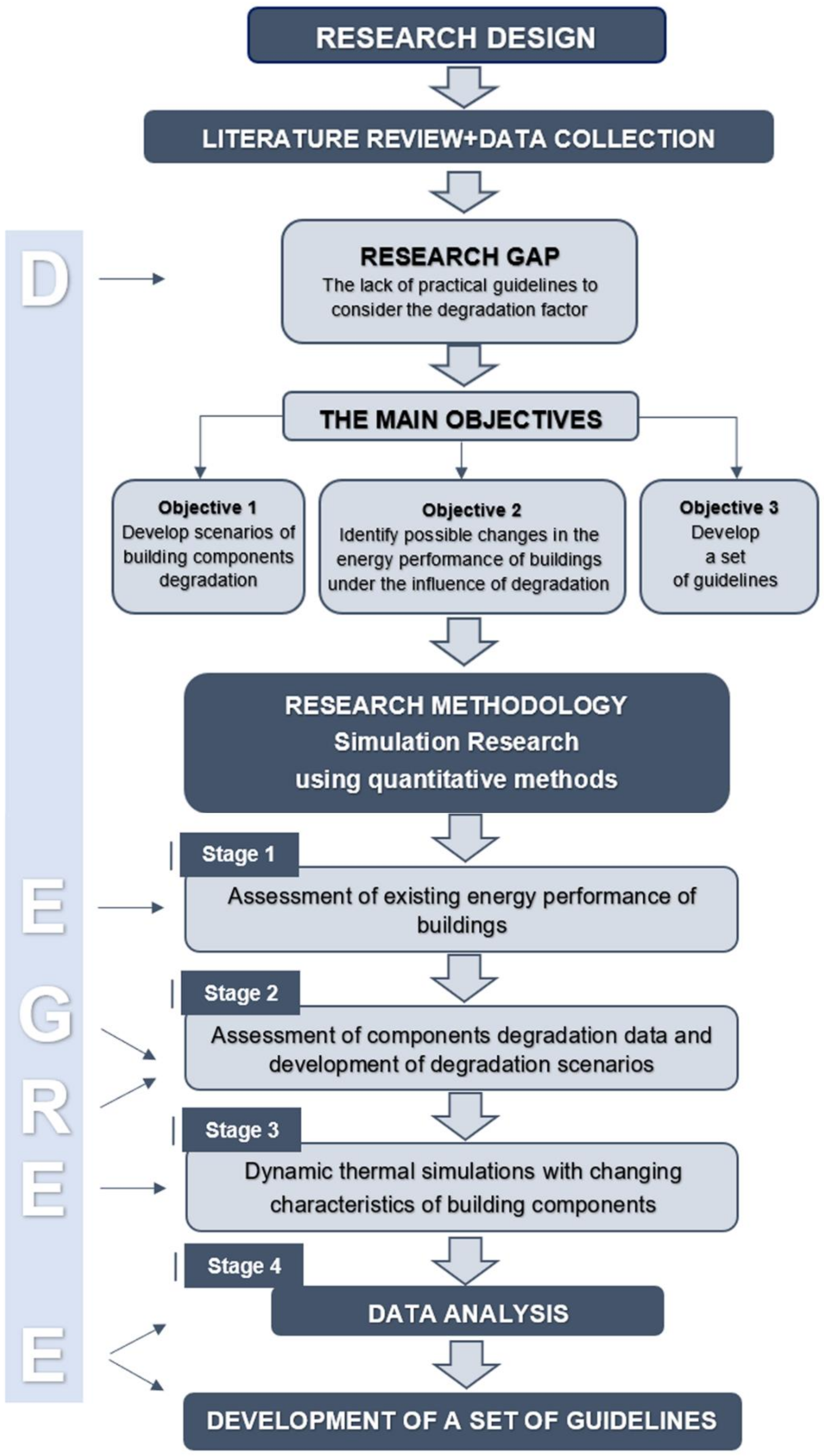
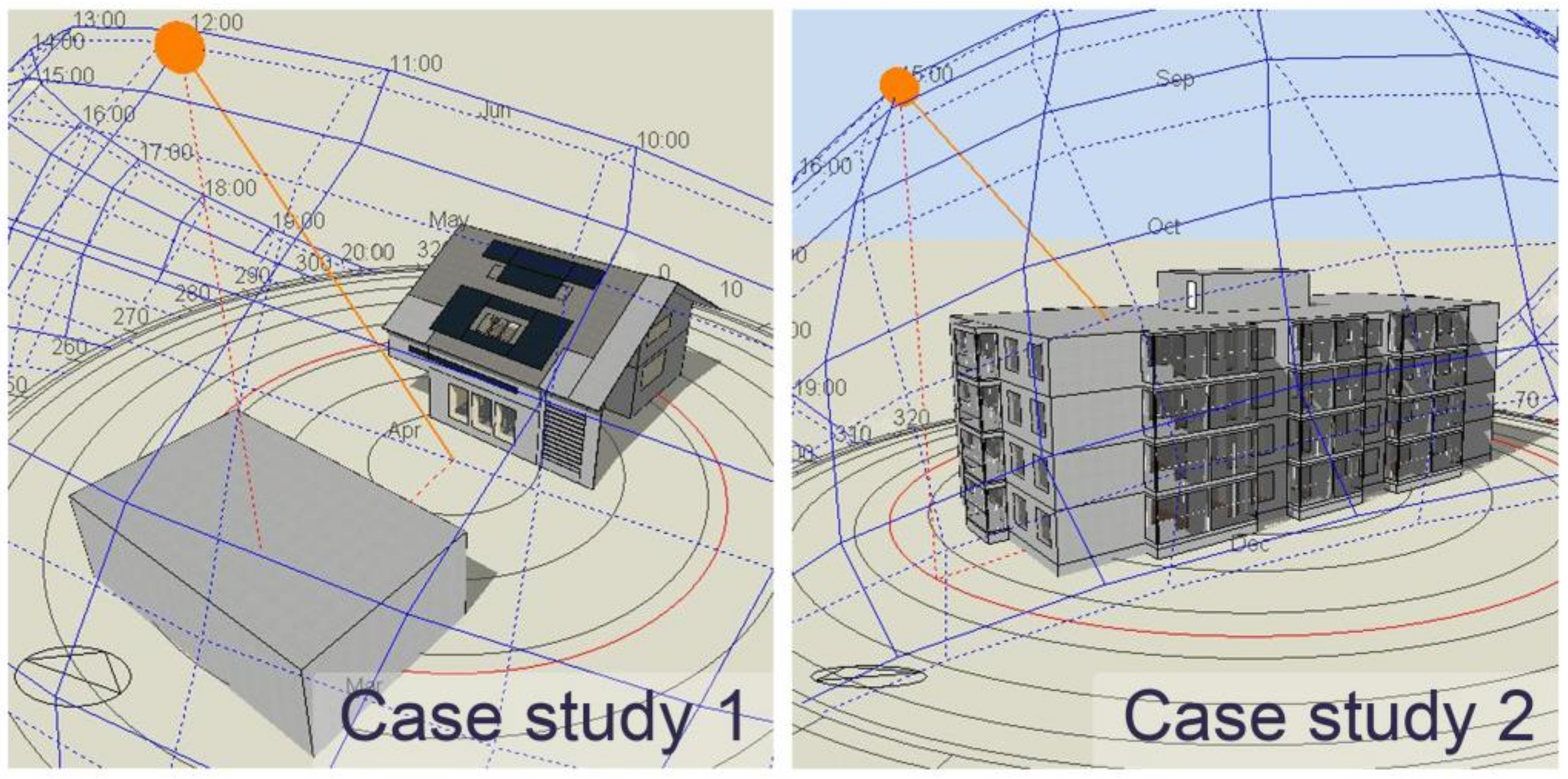

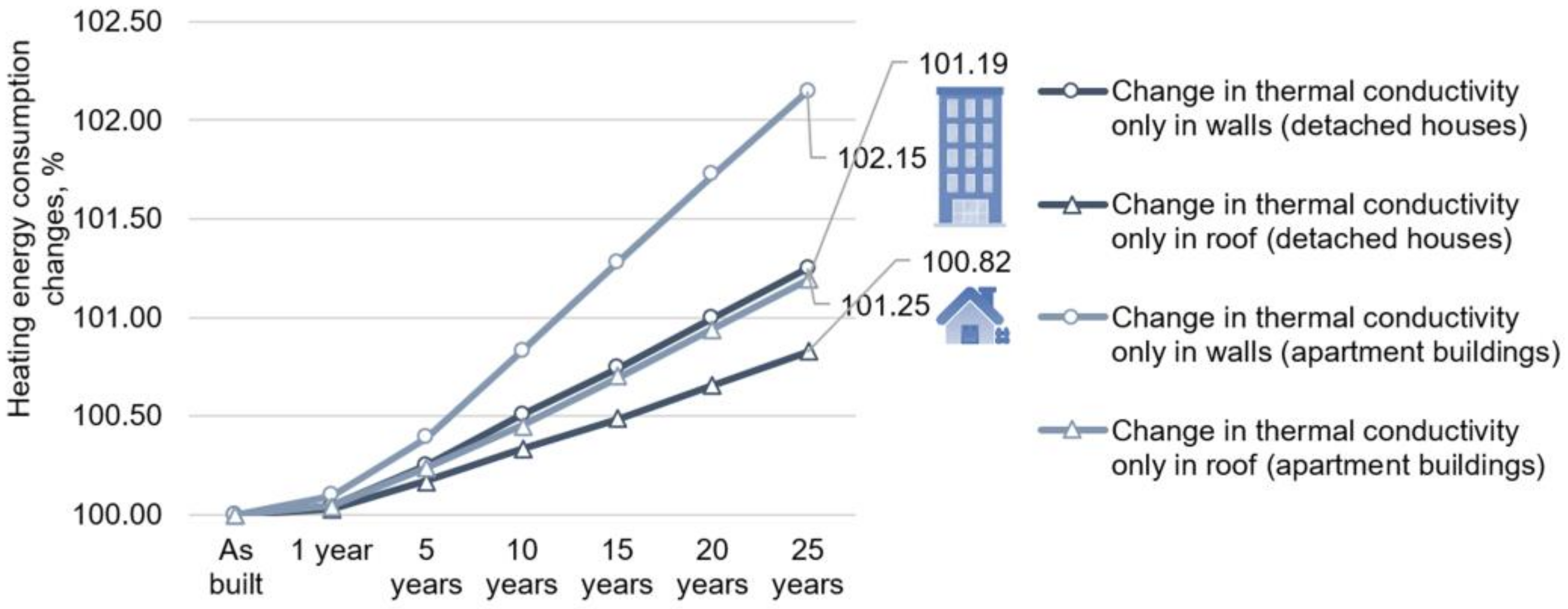


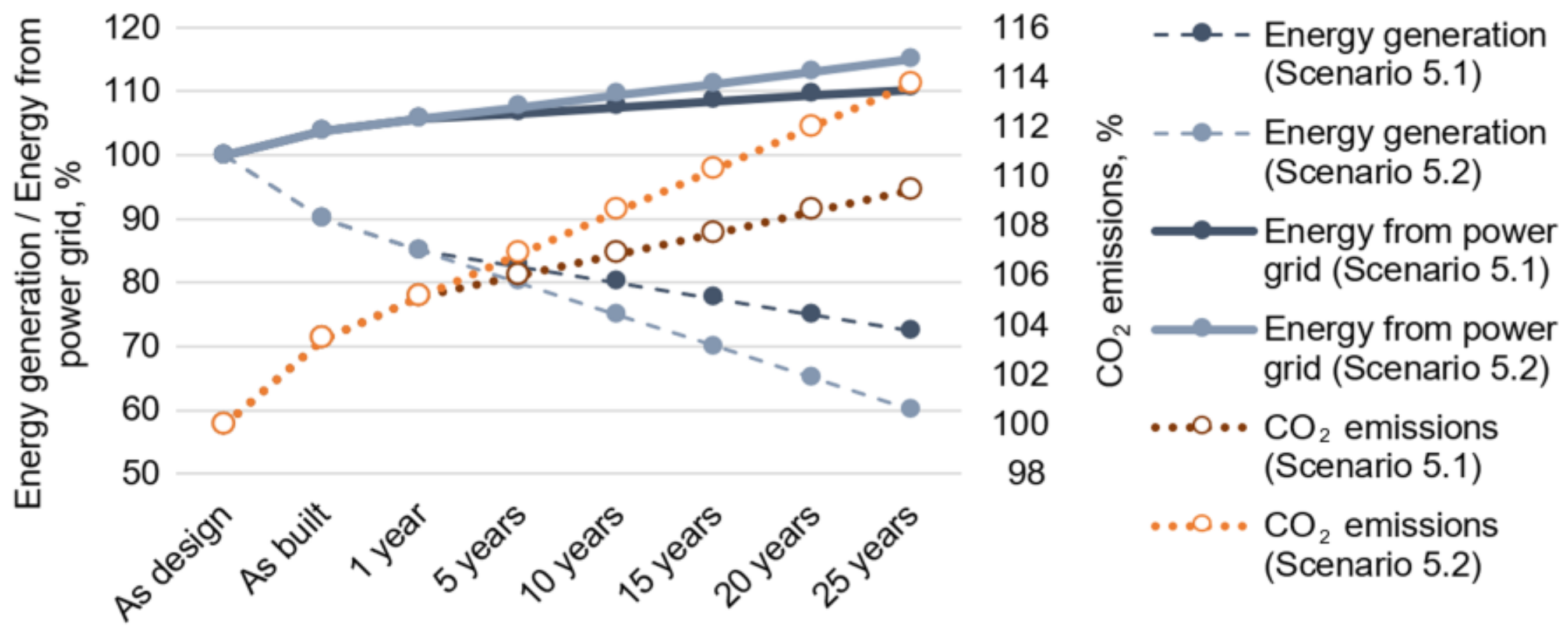


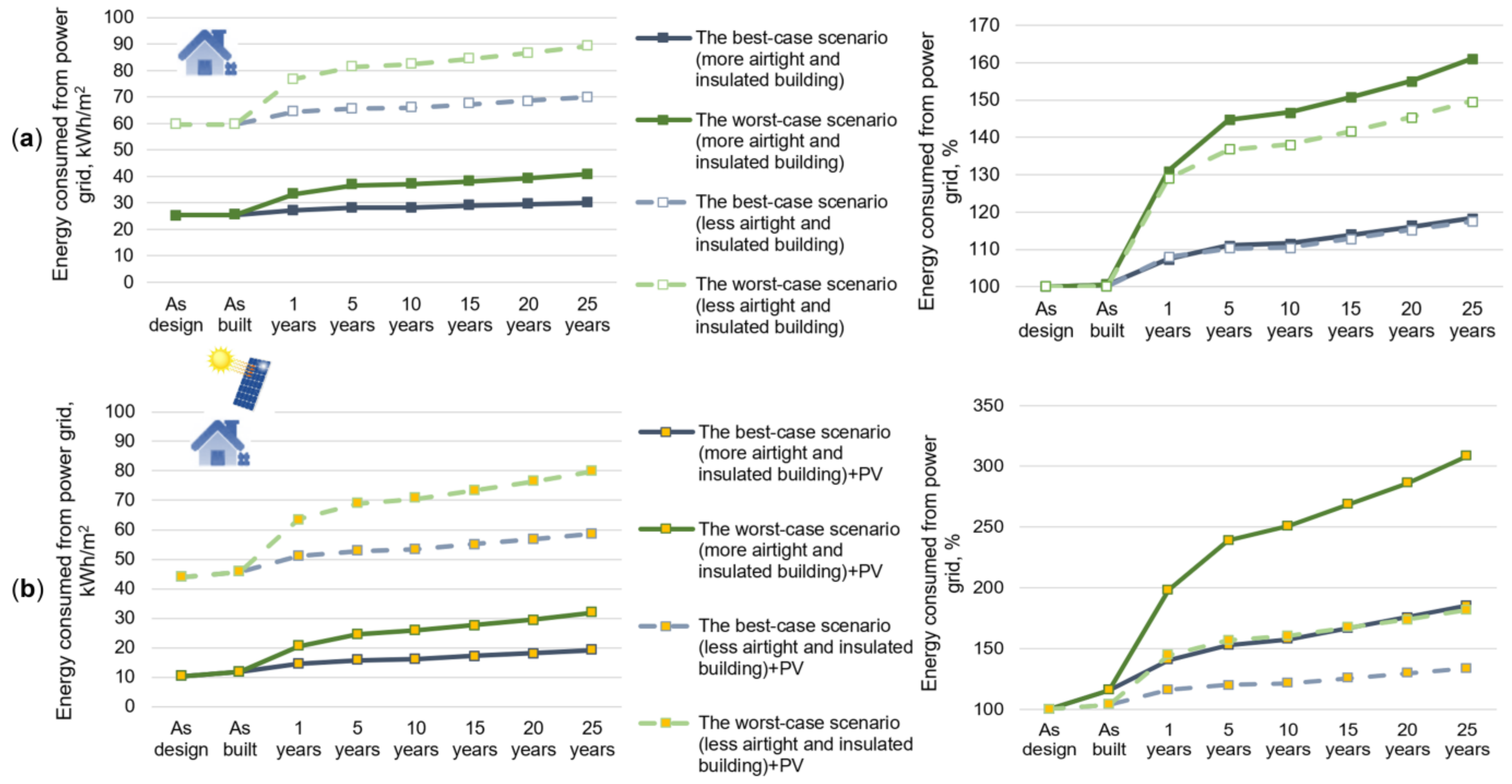
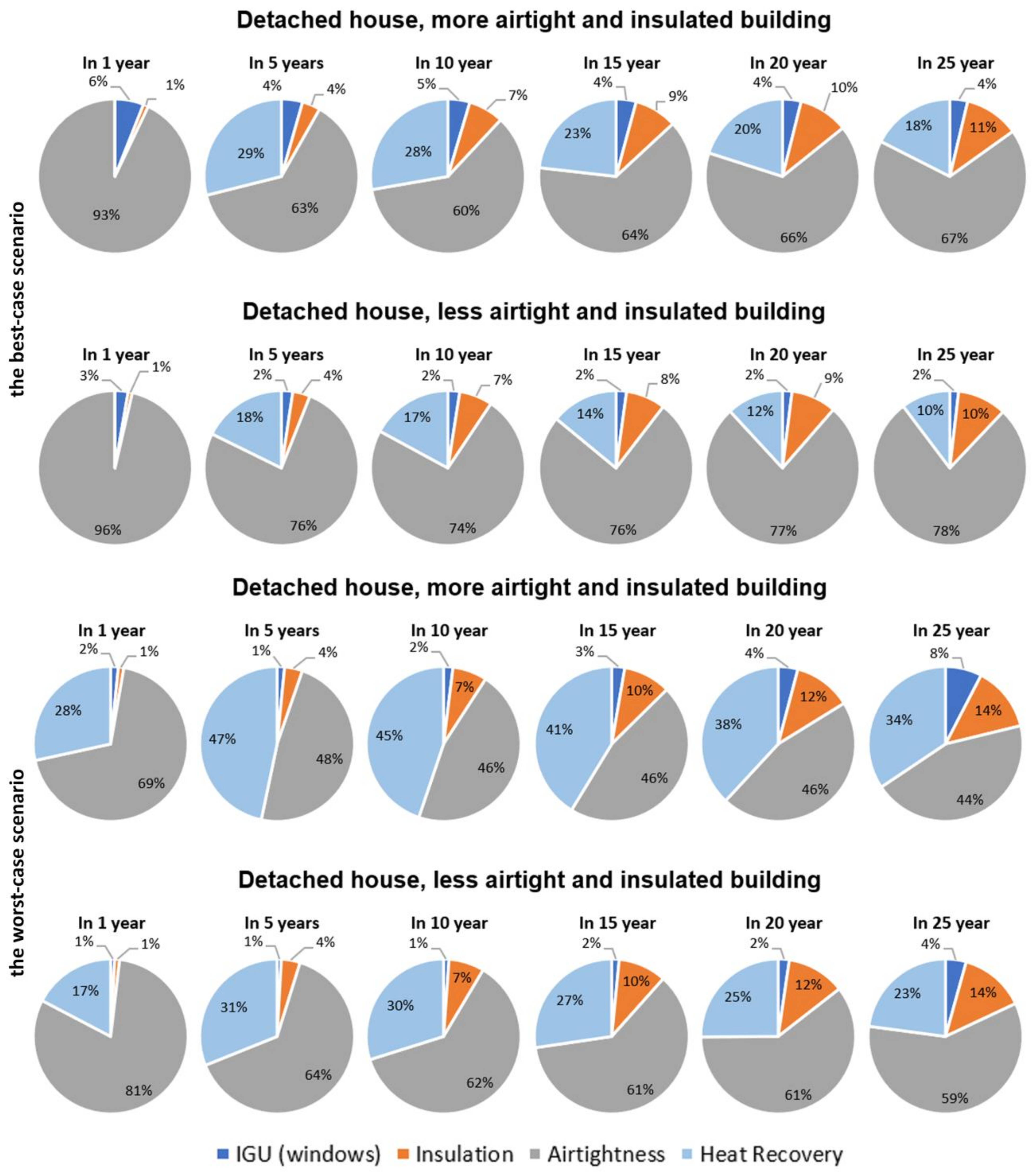


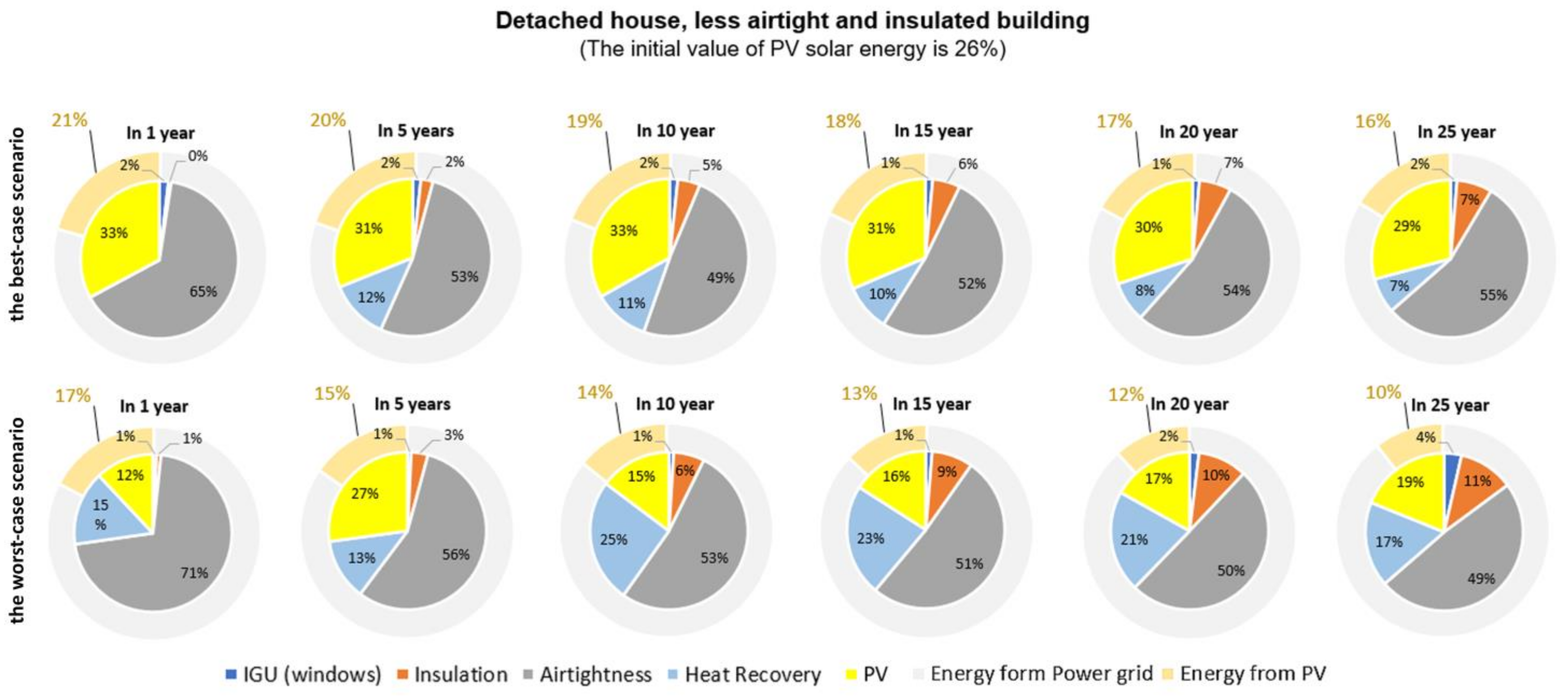
| Case Study 1 | Case Study 2 | ||||||||
|---|---|---|---|---|---|---|---|---|---|
| Location | Dzyarzhynsk (Belarus) | Brest (Belarus) | |||||||
| Type | Detached house | Apartment building | |||||||
| Latitude | LAT 53°41′ N | LAT 52°08′ N | |||||||
| Longitude | LONG 27°08′ E | LONG 23°40 E | |||||||
| Shape | Square | Rectangle | |||||||
| Building length, m | 13.9 | 37.78 | |||||||
| Building width, m | 12.5 | 15.28 | |||||||
| Number of stories | 2 | 4 and a basement | |||||||
| Occupied floor area, m2 | 188.5 | 1861.6 | |||||||
| Occupied volume, m3 | 773.0 | 5383.5 | |||||||
| Unoccupied floor area, m2 | – | 665.7 | |||||||
| Unoccupied volume, m3 | – | 1624.0 | |||||||
| U-value, W/m2K | Walls | More airtight and insulated | 0.078 | Less airtight and insulated | 0.155 | More airtight and insulated | 0.145 | Less airtight and insulated | 0.29 |
| Roof | 0.077 | 0.155 | 0.136 | 0.276 | |||||
| Ground floor | 0.086 | 0.173 | 0.252 | 0.509 | |||||
| Windowswall | 0.96 | 0.96 | 0.96 | 0.96 | |||||
| Windowsroof | 0.83 | 0.83 | – | – | |||||
| External door | 0.93 | 1.475 | 1.475 | 2.95 | |||||
| Airtightness, h−1 | 0.5 | 1.0 | 0.4 | 0.8 | |||||
| Gross Window-Wall Ratio (WWR), % | 9.74–Window-Wall Ratio | 8.2 | 27.35 | ||||||
| 5.6–Skylight-Roof Ratio | |||||||||
| Power density, W/m2 | Kitchen-dining-living room–30.28, bedroom-dress room-study room–3.58, bathroom–1.67, domestic circulation–1.57–2.16, WC–1.61 | ||||||||
| Occupancy schedule | by default | ||||||||
| Setpoint Temperatures: | |||||||||
| Living/Dining | H–21 °C | H–21 °C, HS–12 °C | |||||||
| HS–12 °C | C–25 °C, CS–28 °C | ||||||||
| Domestic circulation, Bathroom/WC | H–20 °C | H–20 °C, HS–12 °C | |||||||
| Bedroom, Dress room, Study room, Kitchen | HS–12 °C | C–25 °C, CS–28 °C | |||||||
| Common circulation areas | H–18 °C | H–18 °C, HS–12 °C | |||||||
| Technical room/Storage | HS–12 °C | C–25 °C, CS–28 °C | |||||||
| Lighting | LED with linear control | ||||||||
| Heating | Underfloor heating | Underfloor heating (CoP = 1.0) | |||||||
| Ground Source Heat pump (CoP = 3.5) | |||||||||
| Cooling | – | Cooling system (CoP = 4.5) | |||||||
| Heating/Cooling season | September-May | October-April | |||||||
| Domestic Hot Water (DHW) | The same as heating | Instantaneous hot water system–CoP = 1.0 | |||||||
| Ventilation | Mechanical with heat recovery (Ventilation rate–1.0 ac/h) | Mechanical with heat recovery (Ventilation rate–1.0 ac/h) | |||||||
| PV modules (ASE 300-DFG/50) | 250W–15 units | – | |||||||
| S = 36.44 m2 | |||||||||
| Building Component | Type of Degradation | № of Scenario | Description |
|---|---|---|---|
| Insulated Glass Units (IGU) | reduction of filling with inert gas | 1.1 | from 90% to 65% |
| 1.2 | from 90% to 85% | ||
| 1.3 | from 90% to 0% | ||
| reduction of filling with inert gas+Low-E coating degradation | 1.4 | from 90% to 65%, ↑SHGC | |
| Thermal insulation | an increase in thermal conductivity | 2.1 | for walls and roof by 12.5% |
| 2.2 | for walls and roof by 50% | ||
| 2.3 | only for walls by 12.5% | ||
| 2.4 | only for roof by 12.5% | ||
| Airtightness | an increase in air permeability | 3.4 | by 37.5% (the case for a detached house with a timber frame in a cold climate) |
| 3.1 | by 27.5% | ||
| 3.2 | by 17.5% | ||
| a decrease in air permeability | 3.3 | by 17.5% | |
| PV modules (only for case study 1) | performance deterioration | 5.1 | by 27.5% |
| 5.2 | by 40% | ||
| Heat recovery of MVHR system | reduction of heat recovery efficiency | 6.1 | by 15% |
| 6.2 | to 0% (in case of complete shutdown of the system) |
| Case Study 1 | Case Study 2 | |||
|---|---|---|---|---|
| 1 * | 2 * | 1 * | 2 * | |
| Total Energy consumption, kWh/m2, including: | 55.17 | 92.95 | 95.33 | 130.21 |
| Room Electricity | 18.49 | 21.62 | 37.44 | 37.12 |
| Lighting | 5.97 | 6.76 | 14.06 | 13.95 |
| Heating | 25.29 | 59.55 | 25.93 | 64.184 |
| Cooling | – | – | 0.35 | 0.25 |
| DHW | 5.42 | 5.02 | 17.55 | 17.41 |
| Energy from PV modules, kWh/m2 | 14.99 | 15.59 | – | – |
| CO2 emissions, kg/m2 | 24.35 | 46.88 | 57.77 | 80.55 |
| Operative temperature, °C | December–20.03 °C | December–19.75 °C | January–18.58 °C | January–17.03 °C |
| July–26.64 °C | July–23.65 °C | July–26.13 °C | July–25.40 °C | |
| Solar gains, kWh/m2 | 43.56 | 45.28 | 16.07 | 15.64 |
| Heat losses, kWh/m2 | ||||
| Windows | −28.47 | −28.00 | −15.50 | −13.23 |
| Walls | −13.73 | −25.67 | −7.13 | −11.89 |
| Roof | −7.85 | −15.32 | −4.39 | −7.51 |
| External infiltration | −72.56 | −169.44 | −50.10 | −89.34 |
| Heat recovery sensible heating (% from the total zone heating) | 77.3% | 43.1% | 34.3% | 16.7% |
| The Operational Stage | Windows (↓Filling with Inert Gas) | Insulation (↑Thermal Conductivity) | Air Permeability (↑) | MVHR (↓Heat Recovery Performance) | PV Modules (↓Performance) | |
|---|---|---|---|---|---|---|
| Scenario 1.2 | Scenario 2.1 | Scenario 3.2 | Scenario 6.1 (Detached) | Scenario 6.1 (Apartments) | Scenario 5.1 | |
| As design | 100 | 100 | 100 | 90 | 65 | 100 |
| As built | 90 | 100 | 100 | 90 | 65 | 90 |
| 1 year | 89.8 | 100.5 | 110 | 90 | 65 | 85 |
| 5 years | 89 | 102.5 | 110 | 75 | 50 | 82.5 |
| 10 years | 88 | 105 | 110 | 75 | 50 | 80 |
| 15 years | 87 | 107.5 | 112.5 | 75 | 50 | 77.5 |
| 20 years | 86 | 110 | 115 | 75 | 50 | 75 |
| 25 years | 85 | 112.5 | 117.5 | 75 | 50 | 72.5 |
| The Operational Stage | Windows (↓Filling with Inert Gas) | Insulation (↑Thermal Conductivity) | Air Permeability (↑) | MVHR (↓Heat Recovery Performance) | PV Modules (↓Performance) | ||
|---|---|---|---|---|---|---|---|
| Scenario 1.3 | Scenario 2.2 | Scenario 3.4 | Scenario 3.1 | Scenario 6.2 (Detached) | Scenario 6.2 (Apartments) | Scenario 5.2 | |
| As design | 100 | 100 | 100 | 100 | 90 | 65 | 100 |
| As built | 90 | 100 | 100 | 100 | 90 | 65 | 90 |
| 1 year | 89 | 102 | 130 | 120 | 50 | 50 | 85 |
| 5 years | 85 | 110 | 130 | 120 | 0 | 0 | 80 |
| 10 years | 80 | 120 | 130 | 120 | 0 | 0 | 75 |
| 15 years | 70 | 130 | 132.5 | 122.5 | 0 | 0 | 70 |
| 20 years | 50 | 140 | 135 | 125 | 0 | 0 | 65 |
| 25 years | 0 | 150 | 137.5 | 127.5 | 0 | 0 | 60 |
Disclaimer/Publisher’s Note: The statements, opinions and data contained in all publications are solely those of the individual author(s) and contributor(s) and not of MDPI and/or the editor(s). MDPI and/or the editor(s) disclaim responsibility for any injury to people or property resulting from any ideas, methods, instructions or products referred to in the content. |
© 2023 by the authors. Licensee MDPI, Basel, Switzerland. This article is an open access article distributed under the terms and conditions of the Creative Commons Attribution (CC BY) license (https://creativecommons.org/licenses/by/4.0/).
Share and Cite
Taki, A.; Zakharanka, A. The Effect of Degradation on Cold Climate Building Energy Performance: A Comparison with Hot Climate Buildings. Sustainability 2023, 15, 6372. https://doi.org/10.3390/su15086372
Taki A, Zakharanka A. The Effect of Degradation on Cold Climate Building Energy Performance: A Comparison with Hot Climate Buildings. Sustainability. 2023; 15(8):6372. https://doi.org/10.3390/su15086372
Chicago/Turabian StyleTaki, Ahmad, and Anastasiya Zakharanka. 2023. "The Effect of Degradation on Cold Climate Building Energy Performance: A Comparison with Hot Climate Buildings" Sustainability 15, no. 8: 6372. https://doi.org/10.3390/su15086372





